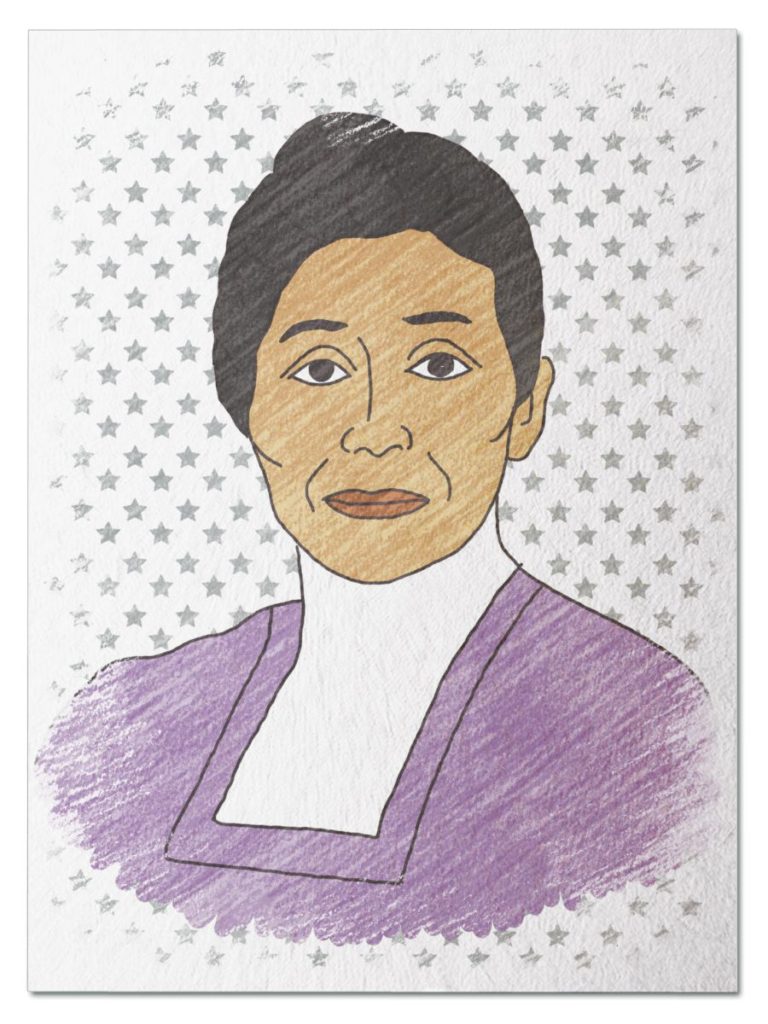
Health Hero
As a young girl on the Omaha Reservation in Nebraska, she witnessed her people not getting the same medical care as white settlers, even though many of the health challenges the Omaha faced resulted from losing their traditional way of life. She had the courage to travel far away from home to become the first Native American woman to graduate from medical school. When she returned, she devoted her career to improving the health and well-being of her people. Join the Omaha Nation in 1913 for the opening of the medical hospital that was the life’s work of Dr. Susan La Flesche Picotte…
Her Ruby Shoe Moment
The Power of the Wand
Her Yellow Brick Road
Brains, Heart & Courage
Glinda’s Gallery
Just the Facts
Her Ruby Shoe Moment
Susan La Flesche Picotte had a lifelong dream. She wanted to build a hospital on the Omaha Reservation in Nebraska. She was the first Native American doctor in America and served the medical needs of the Omaha people. But she couldn’t help anyone who needed acute care — the closest hospital was 30 miles away (a day’s ride by horseback). And that was frustrating.
For years, Susan had watched the health of the Omaha Nation suffer. They were vulnerable to new viruses and bacteria from white people. In addition, their diet suffered as their traditional way of life disappeared. And diseases like measles, tuberculosis and alcoholism spread like wildfire throughout the reservation.
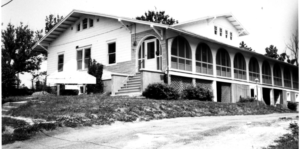
Dr. Susan La Flesche Picotte Memorial Hospital (National Park Service)
Susan spent her entire medical career on the Omaha reservation. She saw patients for many years. She also educated the community about the importance of good hygiene and sanitary living conditions. In addition, she focused on disease prevention and lobbied for better access to vaccinations. Finally, Susan got involved in public health policy at both the state and county levels.
In 1910, Susan’s dream of a hospital on the Omaha reservation started to become a reality. Her sister donated one acre of land in Wathill, Nebraska for a future hospital. Then, Susan worked with William Steele (an architect from Sioux City, Iowa) to design the building. And she wanted to incorporate all she had learned about good health and sanitary conditions — large open spaces; a screened porch to keep out flies; large windows for fresh air; private bathrooms; and a state-of-the-art kitchen.
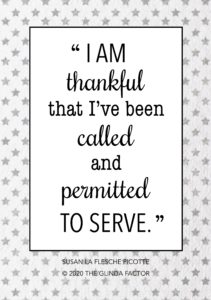 Mr. Steele estimated that it would cost $10,000 to build the hospital of Susan’s dreams. Which was a lot of money back then (about $300,000 today). But she refused to give up. Susan threw herself into fundraising for the hospital — she wrote friends back East; she requested grants from mission groups; she held fundraisers; and she asked local organizations for donations.
Mr. Steele estimated that it would cost $10,000 to build the hospital of Susan’s dreams. Which was a lot of money back then (about $300,000 today). But she refused to give up. Susan threw herself into fundraising for the hospital — she wrote friends back East; she requested grants from mission groups; she held fundraisers; and she asked local organizations for donations.
Susan raised all the funds needed for the hospital — the Home Mission Board of Presbyterian Church donated $8,000, the Quaker Society of Friends donated $500, and local organizations donated the rest (including proceeds from a benefit concert). Finally, construction began. The hospital was completed in January, 1913. It was the first private hospital built on an Indian reservation in America.
Unfortunately, Susan never saw patients at the hospital because of her poor health. And she died two years after it opened. But her legacy went on — the hospital was a huge success and served both the Native population and the neighboring white communities until 1947. In 1993, the Susan La Flesche Picotte Center became a National Historic Landmark. In 2018, it was in such disrepair that it was listed among the 11 Most Endangered Historic Places. Today, the Memorial Hospital Restoration Initiative is raising money to save the building.
The Power of the Wand
Susan La Flesche Picotte was the first Native American to receive a medical degree in America. And she devoted her entire career to improving the health and welfare of the Omaha people in countless ways. Her efforts were successful, in part, because she served as a bridge between the Native traditions and “white” culture. Susan leveraged her unique position to make a difference in her community and paved the way for other women to do the same.
EllaMae Looney is doing her part to preserve the history and culture of Native communities. She is a member of the Yakama Nation and is learning 3 Native languages spoken in her community (Walla Walla, Nez Perce and Umatilla). Her goal is to study linguistics at University of Oregon and help preserve Native languages for the next generation of American Indians. Her efforts have been recognized by the Center for Native American Youth at the Aspen Institute.
Her Yellow Brick Road
After graduating from medical school, Susan returned home to serve the Omaha people. Within months, she became the doctor for the Omaha Indian Agency school. She was responsible for the health of its students and teaching a class on proper hygiene. She was paid $500 per year by the federal government (which was 10 times less than an Army doctor).
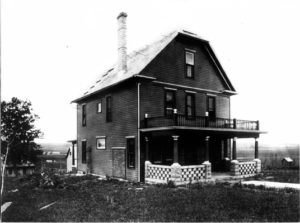
Susan’s house on the Omaha Reservation (Smithsonian Institute)
Before long, people across the entire reservation turned to Susan for medical care. And she treated everyone who came to her (even though she wasn’t paid for it). She became the primary doctor for the entire reservation — more than 1200 people spread over 1350 square miles. She routinely worked 15 hour days and was constantly on the road making house calls. One winter, she traveled by horse and buggy to treat over 700 people across the reservation.
After four years as the reservation doctor, Susan’s health issues forced her to resign. She literally sacrificed her health to serve others. Susan suffered from chronic headaches, backaches, and ear infections — each round of illness took longer for her to recover. In fact, her ears suffered permanent damage from riding in the freezing temperatures and fierce winds every winter. She was partially deaf for the rest of her life.
 Eventually, Susan set up her own medical practice in Bancroft. It became a community gathering place, with Susan providing assistance with a wide variety of matters (medical or not) — she drafted documents; she wrote letters; she helped to resolve disputes; she had small library and taught children to read; she was a resource for women; and she fought any injustice that she witnessed.
Eventually, Susan set up her own medical practice in Bancroft. It became a community gathering place, with Susan providing assistance with a wide variety of matters (medical or not) — she drafted documents; she wrote letters; she helped to resolve disputes; she had small library and taught children to read; she was a resource for women; and she fought any injustice that she witnessed.
Susan was also a tireless advocate for the Omaha nation at the federal, state, and local level. She joined the state medical society and lobbied to get health related bills through the state legislature. She also served on both the county medical board and the Wathill health board, and pushed for health inspection of schools and playgrounds. She also discouraged alcohol on the reservation and tried to prevent violence and abuse within families. No topic was off limits for Susan if it had the potential to improve health and wellness for the Omaha people.
Brains, Heart & Courage
Susan grew up on the Omaha Reservation in Nebraska with three sisters. Her mom, Mary (“One Woman”), was the daughter of an army surgeon and her dad, Joseph (“Iron Eyes”), was the son of a French fur trader. When he was 28 years old, her father was adopted by the Chief of the Omaha Nation. He went on to become the last Chief of the Omaha Nation.
As Susan grew up, she learned to respect their Native heritage and traditions while also gaining the skills to navigate the “white” world. Her father encouraged assimilation and wanted to ensure the Omaha Nation’s survival while also honoring its cultural identity. So he embraced Christianity, spoke French, lived in a clapboard wood house, and promoted education — in fact, Susan and her siblings all traveled East to attend school.

Susan at her graduation (National Park Service)
Susan knew she wanted to be a doctor from a young age. Legend says she witnessed a Native woman die in pain because the local white physician refused to treat her. And it made a big impact on her. She was convinced that Native Americans deserved better medical care. And she was determined to make a difference.
Susan went to school out East when she was 14 years old. She attended the Elizabeth Institute for Young Ladies in New Jersey for 2 1/2 years, the same school as her sisters. Then, she attended the Hampton Normal and Agricultural Institute in Virginia for 2 years (it was a school for blacks, but also accepted Native Americans). She graduated second in her class in May, 1886 and gave the commencement speech in front of a crowd of 1,000 people.
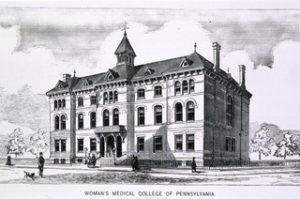
Women’s Medical College of Pennsylvania (National Library of Medicine)
Then, Susan was accepted into the Women’s Medical College of Pennsylvania. It was unclear how she would pay for it, however. At the last minute, she received financial assistance from the Connecticut Indian Association, Women’s National Indian Association and US Office of Indian Affairs. Philadelphia was an eye-opening experience for Susan — she was immersed in the “white ways.” She was a very serious student and was at the top of her class.
Susan graduated in March, 1889 at age 24 and became the first Native American to receive a medical degree in America. She had a number of job opportunities at prestigious institutions, but she decided the return to the Omaha Reservation to help her people.
Glinda’s Gallery
Just the Facts
- Susan was born June 17, 1865 on the Omaha reservation in Nebraska. Legend says she was born in a tipi during a buffalo hunt. She was the fourth, and youngest, sibling.
- Susan became an American citizen while she was in medical school (all members of the Omaha Nation became citizens on February 7, 1887).
- Susan could speak 4 languages — English, French, and 2 Native languages.
- Susan’s siblings were all successful as well — Margeurite was headmistress of the reservation school and Suzette was an Indian reformer and spoke about the injustices (she was the first woman to speak at Faneuil Hall).
- Susan married Henry Picotte in June, 1894 and they had two sons, Caryl and Pierre. Henry died when her kids with 7 and 9 from tuberculosis and alcoholism.
- Susan and her sister started the “Order of the Eastern Star.” She also organized a Presbyterian church in Salt Hill, on the reservation.
- In 1910, Susan was part of a delegate that traveled to Washington DC and met with top government officials for 6 weeks. They achieved their mission of defending Omaha land interests and achieving individual ownership rights for members of the Omaha tribe. Unfortunately, the goal of self-support through land ownership failed — whites took advantage of the Omaha and either bought or rented land for a deeply discounted price.
- In 1914, Susan was diagnosed with “decay of the bone” (probably cancer). She had two surgeries, but wasn’t able to control the disease. The first operation was Feb 1915 to remove the infected bone. The second operation was a month later. But the disease spread. Marie Curie even sent her medicine from France in the hopes it would help (it was a radium pellet).
- Susan died on September 18, 1915 at ago 50. Tributes came in from all over the country.
- Susan’s 152nd birthday was honored with a Google Doodle on June 17, 2017
Want to Know More?
Riley, Glenda. By Grit and Grace: Eleven Women Who Shaped the American West. Golden, CO: Fulcrum Publishing, 1997.
Starita, Joe. A Warrior of the People: How Susan La Flesche Overcame Racial and Gender Inequality. New York: St. Martin’s Press, 2016.
Tong, Benson. Susan La Flesche Picotte, MD: Omaha Indian Leader and Reformer. Norman: University of Oklahoma Press, 1999.
Vaughan, Carson. “The Incredible Legacy of Susan La Flesche, the First Native American to Earn a Medical Degree.” Smithsonian Magazine. March 1, 2017.
Dr. Susan La Flesche Picotte Center
LaFlesche Family Papers are at the Nebraska State Historical Society.
Susan La Flesche Picotte. National Park Service.
